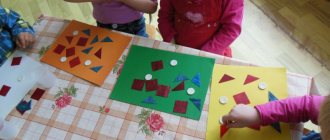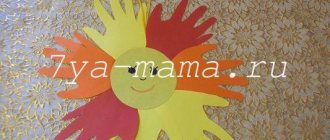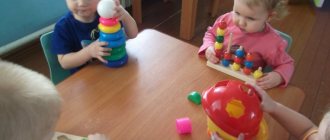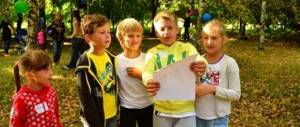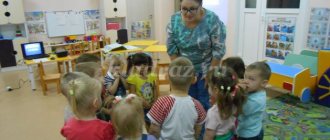Game "Inflate, Bubble!"
Business game for teachers of preschool educational institutions “Game is the leading activity of preschoolers” Topic “Game is the leading activity of preschoolers” Purpose: To broadcast the experience of the teaching staff of preschool educational institutions on the topic “Game activity.
Didactic game "Shop". Plot-role-playing game of older preschoolers How the independent plot-role-playing game of older preschoolers changes under the influence of the systematic formation of new games in them.
Didactic game “Memo. My Novosibirsk." DIY printed board game for children GAME “MEMO. MY NOVOSIBIRSK" (didactic game 4+) Educators of MADOOU d/s No. 500: Gazieva Yu. V. Pokhlamkova L. N. Currently exists.
Didactic educational game “What different fish” for children from 3 to 7 years old I would like to present you with a version of my game “What different fish” You can start playing this game with children of three years old and as they get older.
Card index of round dance games: “Loaf”, “Ball”, “Zainka”, “Even Circle”, “Big Carousel”, “Bubble”, etc. Card index of round dance games Card No. 1 “Loaf” Purpose of the game: To train children in correct coordination of actions and text, educate.
Summary of OOD on cognitive development with children of the preparatory school group “Blow up the Bubble” Summary of organized educational activities on cognitive development with children of the preparatory school group “Blow up the Bubble”.
Magnetic game "Bird House". Didactic game for children 5–7 years old Goal: the formation of environmental education in preschoolers, expressed in a humane and valuable attitude towards the world of birds, as one of the most important.
Methodological development on the island. O. “Cognition” middle group “Blow up your soap bubble” Methodological development in the educational field “Cognition” “Blow up your soap bubble” (middle group) Before giving knowledge.
Educational activity during the period of adaptation to the conditions of the preschool educational institution “Cheerful Soap Bubble” in the first junior group Educational activity “Soap Bubbles” in the second junior group Goal: overcoming stressful conditions in young children.
Tactile game “Count and tell everyone.” Visual game “Guess by the shadow” These games are for middle and older ages. Both games, in my opinion, are very interesting and, moreover, they do not require much time to make. When.
Relay race with soap bubbles
Relay race with soap bubbles.
Divide the children into two teams and line them up at the starting line.
Place a cone-shaped structure or some other identifying mark a few meters (not far, 2-3 meters is enough) from the starting line; you can stand close to a bush or tree and mark it as a border.
Players, one at a time, must blow a bubble and then catch it on their blowing stick. As soon as the child catches the bubble on a stick, he must rush to the identification mark and back. The bubble must not burst or fly off the stick (if this happens, the player must go back and start again).
When the children return to their teams, the sticks are passed to the next player in line, who must do the same.
The game continues until one team completes the task. This team wins.
Summary of the outdoor game “Cow” in the middle group of preschool education.
Organization of outdoor play in the middle group Speech at the Moscow Region Performed by: Gorskaya Natalya Yuryevna, Topic: “Organization of outdoor play in the middle group and safe behavior skills.
Summary of a comprehensive lesson on speech development “Cow and Calf” for middle group children Purpose: to teach children to describe a picture in a certain sequence. Objectives: “Speech development”: Teach children to describe a picture by composing.
Notes on conducting an outdoor game in the senior group “Hunters and Hares” Name of the game “Hunters and Hares” Time and place: the first half of the day’s walk, in the group’s area. Preparing for the game: together.
Summary of an outdoor game for the first and second junior groups “Mice and Norushki” Purpose: • Continue to teach children to perform actions in accordance with the words of the poem. • Move at different paces, change directions.
Synopsis of the outdoor game “Two Camps” senior preschool age Synopsis of the outdoor game “Two Camps” Gonchar S.N. – teacher Purpose: Formation of patriotic feelings through outdoor games.
Synopsis of the outdoor game “Shaggy Dog” for children of the second junior group Synopsis of the outdoor game “Shaggy Dog” for children of the 2nd junior group Purpose: - To consolidate the children’s skill in running wild. -Develop dexterity.
Summary of the outdoor game “Gifts” Summary of the outdoor game “Gifts” Purpose: To teach children to follow the rules of the game. Practice the ability to act on a signal and walk.
Quest technology in preschool educational institutions. Summary of the game-activity in the preparatory group “A parcel from Grandfather Bukvarik” Quest for children of the preparatory group “Zvezdochka” “A parcel from Grandfather Bukvarik” Teachers: Smirnova I. A., Tonkikh E. N. Goal: to promote.
Plan - outline of the outdoor game "Planes" in the middle group Plan - outline of the outdoor game "Planes" for the middle group. Venue: physical training ground on the territory of the Preschool Educational Institution Program.
Summary of a lesson using an outdoor game for the senior group “Two Frosts” Purpose: To introduce children to the outdoor game “Two Frosts”, promote team unity, and develop the ability to act in accordance.
Children's holiday
→ Children's party → Organizing a children's party
Soap bubbles are a summer fun that every child is truly delighted with! They shimmer in the sun and play with all the colors of the rainbow, rise up and burst there. There are many recipes for preparing a solution for soap bubbles. We offer three of the most popular and easy to prepare. Option one
For 200 g of any detergent you need to take 600 ml of water and 100 ml of glycerin (sold at the pharmacy).
Stir everything well. With glycerin, the bubbles are denser. Option two
A piece of laundry soap should be grated on a coarse grater.
Dissolve 4 tbsp in 400 ml of hot water. l. soap shavings. Let the solution stand for a week so that the soap dissolves, then add 2 tsp to it. Sahara. Leave until the sugar dissolves, then stir - done. This recipe is more complicated than the first, but it’s worth it - the bubbles are dense, the mass is very foamy and productive. Option three
We will need: 50 ml of shower gel (you can take shampoo or liquid soap), 60 ml of water, 0.5 teaspoon of sugar. Combine everything, mix. Ready!
Colored bubbles Soap bubbles can be colored - it will be a real soap firework that will delight any child! To do this, pour the prepared solution into small jars and color with food dyes of different colors. You can not only blow such bubbles, you can draw with them! Prints of colored bubbles on paper blend very well into intricate patterns and can also be used to create colorful backgrounds for other creative works. You can draw with colored bubbles on pieces of cardboard, wallpaper, or snow.
Airy “matryoshka” It is very interesting to blow bubbles one inside the other, according to the matryoshka principle. To do this, you need a flat surface (for example, a flat plate) and a thin straw. Grease the bottom of the plate with the solution. Inflate the first bubble so that it lies in a hemisphere on the plate. Now carefully insert the straw inside this bubble and blow the second bubble inside. And so on - third, fourth... You can compete to see who can blow the most bubbles. This is a fun activity for the whole family!
Don't let them fall Children try to do everything possible to prevent soap bubbles from falling to the ground for as long as possible.
Blow up more Children take turns blowing up as many soap balloons as possible and counting them. The one who blows them out the most wins. Great ways to remember numbers.
Catch on command Children “catch” bubbles only on a special command: squatting, on one leg, with one hand, on tiptoes, only with their head, with a finger, etc.
Juggling You can try juggling soap bubbles using wire rings.
Soap miracle in hand Dip your hands in the soap solution and blow bubbles with your index finger and thumb. Soap balls will be right in your hands. Very funny!
Who has the biggest bubble ? You can have a competition to see who can inflate the biggest bubble.
Soap cocktail Pour some soap solution into a jar. Take a straw and start blowing hard into it. You will quickly form foam that will happily fall out of the edges of the container.
Who can catch the most bubbles Children chase soap bubbles, trying to “catch” as many of them as possible.
Votes: 2
Add a message
Water games for the second younger group. Card index
Water games for kindergarten. Second junior group
Card index of water games for the second junior group
“Cucumber” Purpose of the game:
learning to move in water.
Description of the game
: The players hold on to the handrail of the pool and say: “Cucumber, cucumber, don’t go to that end.
A mouse lives there and will bite your tail off.” With the end of the words, the children move to the opposite wall of the pool. Rules of the game: no pushing. Note: the instructor marks the children who walked more carefully in the pool, not forgetting to praise all the children, creating positive emotions. Literature:
E.N. Vavilova “Teach to run, jump, climb, throw” Page 40
“The sea is agitated” Purpose of the game:
to help children get comfortable in the water, to become familiar with its resistance.
Game description:
Children stand in a column one at a time.
At the instructor’s command, “The sea is rough!” children run in any direction (they are “accelerated by the wind”), make any hand movements, and plunge. When the instructor says: “The wind has died down, the sea has calmed down!”, the children must quickly take their places in the column. Rules of the game:
The instructor says: “One, two, three - that’s where we stand.”
Note:
You can use formation in a circle, in one line.
A latecomer may be considered out of the game and taken aside. Literature:
T.I.
Osokina “How to teach children to swim” P. 59 “Train into a tunnel” Waist-deep water Goal of the game:
improve the ability to slide on your chest.
Description of the game:
The players line up in a column one at a time, placing their hands on each other’s shoulders, depicting a train.
The column moves at a pace. Two guys, facing each other and holding hands, form a tunnel, lowering their hands to the surface of the water. To drive through it, the guys pretending to be a train take turns going forward of the column and performing a chest slide. After all the cars have passed, the children representing the tunnel line up at the end of the column, and the first two children from the train form a new tunnel. Rules of the game: You can only return to the end of the column by walking. Oncoming traffic is prohibited - there is only one track in the tunnel, and a crash may occur. Note:
The teacher must ensure that those depicting the tunnel do not detain the children under water.
Literature:
M.D.
Makhaneva G.V. Baranova “Figure swimming in kindergarten” Page 52 “Seine” Waist-deep water Purpose of the game:
to help get comfortable with water resistance.
Description of the game:
The players (fish) are located in a limited space.
Two fishermen, holding hands, at the instructor’s signal, run after the fish, trying to surround it. Every fish caught remains in the fishermen's net. This is how the net is gradually formed. The game ends when all the fish have been caught. Rules of the game: You cannot fish with a torn net. You can’t push, drown each other, grab each other’s arms or body. Note:
The driver is appointed by the instructor.
The last one caught is declared the fastest fish. Literature:
M.D.
Makhaneva G.V. Baranova “Figure swimming in kindergarten” Page 53 “Crossing” Purpose of the game:
to make you feel the resistance of the water for the correct implementation of water for the correct implementation of rowing movements of the arms.
Description of the game: The players line up in one line Rules of the game:
You can only return to the end of the column by walking.
Oncoming traffic is prohibited - there is only one track in the tunnel, and a crash may occur. Note:
The teacher must ensure that those depicting the tunnel do not detain the children under water.
Literature:
M.D.
Makhaneva G.V. Baranova “Figure swimming in kindergarten” Page 52 “Sun and Rain” Purpose of the game:
To teach children to walk and run in all directions without bumping into each other..
Description of the game:
Children stand at the wall of the pool.
The instructor says: “Sunny! Go for a walk!” Children walk and run all over the pool. After the words “Rain! Hurry home! The children run to their places. When the instructor says “Sunny! Go for a walk!” You can go for a walk, the game repeats. Rules of the game:
First, 5-6 children take part in the game.
When repeated, everyone can play. Note:
Instead of houses (pool wall), you can use an umbrella.
Literature:
E.A.
Timofeeva Outdoor games with children of primary preschool age. Page 38. “Carousel” Purpose of the game:
to teach movement along the bottom of the pool, learning to form in a circle
Description of the game:
Holding hands in the water, start moving in a circle, gradually speed up your step, saying: “Barely, barely, barely the carousel began to spin, and then, then, then - all running, running, running.”
Run in a circle, and then say: “Quiet, quiet, don’t rush, stop the carousel.” Gradually slow down and say: “The game is over. Stop - once and twice! - stop. Rules of the game:
First, 5-6 children take part in the game.
When repeated, everyone can play. Note:
Repeat the game in a circle in the opposite direction.
Literature:
T.I.
Osokina “How to teach children to swim” P. 60 “Train” The purpose of the game:
to help children get comfortable on the water, to teach children to follow each other.
First holding on to each other, then not holding on; Game description: Children stand one after another. Each child depicts a carriage, and a steam locomotive (an adult) stands in front. The locomotive whistles and the train begins to move - first slowly, then faster. Approaching the station (pre-marked place), the train slows down and stops. Then the locomotive blows its whistle and movement resumes. Rules of the game:
You cannot push or overtake each other;
Note:
When pretending to be a train, each child can freely rotate his arms, hum, and say “choo, choo, choo!”
Literature:
E.Ya. Stepanenkova Collection of outdoor games for children 2-7 years old p. 17
“Cheerful Bunnies” Purpose of the game:
learning to jump on two legs in a playful manner, developing dexterity and coordination of movement.
Description of the game: Children “Hares” perform movements in accordance with the text. Well, everyone sat down together, looked at each other, patted their paws: Clap and clap, Clap and clap. What do rabbits have on top of their heads? -The ears are dancing merrily. One jump, two jumps - They all galloped into the woods. Rules of the game:
Children “Hares” perform movements in accordance with the text.
Note:
The instructor performs the movements together with the children.
Literature:
K.K.
Utrobina Entertaining physical education for preschoolers 3-5 years old page 25 “Airplanes” Purpose of the game:
To teach children to run in different directions without bumping into each other.
Game description:
Children are standing at the side of the pool - this is an airfield.
Kids are pilots. “Are the pilots ready to fly?” - asks the instructor. The children answer: “Ready!” “Start the engine!” - says the instructor. Children rotate their right hand as if starting a motor, saying “tr-tr-r.” The instructor is ready to fly. “Pilots” fly around the entire basin in airplanes. The instructor says, “For landing.” Everyone returns to the airfield. Then the signal to fly is given again and the game is repeated. Rules of the game: Note:
For children to relax when they sit on the benches.
You can check the tires and pump fuel. Literature:
E.Ya. Stepanenkova Collection of outdoor games for children 2-7 years old p. 22
“Hare Concert” Purpose of the game:
Teaching the basic types of movement, developing discipline and attentiveness.
Description of the game:
Children “Hares” perform movements in accordance with the text.
A whole bunch of hares jumping one after another along the edge of the ravine on two legs. Entertains everyone with jumping. Jump-jump, jump-jump. They beat the drums deftly: Imitate the beats of Tra-ta-ta, tra-ta-ta. Drum (palms). And then, so theatrically, into musical cymbals to imitate playing the cymbals. They hit: ding-la-la. Having fun with all my heart. Rules of the game:
Jumps are performed on two legs.
Note:
The instructor marks the children who jumped better, not forgetting to praise all the children, creating positive emotions.
Literature::
K.K.
Womb Entertaining physical education for preschoolers 3-5 years old page 28 “Corydalis Hen” Purpose of the game: Description of the game:
The instructor portrays a chicken, the children depict chickens.
One child is a cat. She sits on a chair to the side. The hen and chicks walk around the room. The instructor says:
The crested hen has come out.
There are yellow chickens with her, The hen clucks: “Ko-ko, don’t go far.” Approaching the “cat,” the instructor continues: On the benches by the path, The cat lies down and dozes... The cat opens its eyes and catches up with the chickens. The “cat” opens its eyes, meows and runs after the chickens, which run away to the “house”, to the mother chicken. Mother hen protects the chicks. Rules of the game:
Act according to the words of the poem.
Run away from the “cat” to the “chicken”. Note:
The hen protects the chicks by spreading her arms.
Literature:
E.Ya. Stepanenkova Collection of outdoor games for children 2-7 years old p. 36
“Bird and chicks” Purpose of the game:
To teach children to depict the flight of birds.
Description of the game:
The instructor invites the children to play and explains: I will be a bird, and you will be my chicks.
Draws a circle - That’s how big the bird’s nest is! Come inside! The children come in and squat down. The teacher gives the signal “Let’s fly, fly for food!” “Chicks” jump out of the nest and fly around the room, “Mother Bird” flies with them. Then she says “let’s fly home.” The "chicks" are flying home. Rules of the game: You can fly out of the nest only after the words “Let's fly, fly for food!” Note:
The game is repeated several times.
Literature:
E.Ya. Stepanenkova Collection of outdoor games for children 2-7 years old p. 47
“Mice and a cat” Purpose of the game:
To teach children to run easily, on their toes, without bumping into each other
Description of the game:
Children sit on benches on one side sites.
These are mice. The instructor stands on the opposite side. He portrays a cat. The cat falls asleep (closes his eyes), and the mice scatter throughout the room. But then the cat wakes up, stretches, meows and starts catching mice. The mice quickly run away and hide in holes (take their places.) The cat takes the caught mice to his place. When the rest of the mice hide in their holes, the cat walks around the room again, then returns to its place and falls asleep. Rules of the game:
Mice can run out of the hole only when the cat closes his eyes.
Note:
Arches for crawling can serve as minks.
Literature:
E.A.
Timofeeva Outdoor games with children of primary preschool age. Page 43 “Shaggy Dog” Purpose of the game:
To teach children to move in accordance with the text, to quickly change the direction of movement.
Game description:
Children stand on one side of the hall.
One child is on the opposite side, pretending to be a dog. The children quietly approach him in a crowd, at which time they say: Here lies a shaggy dog, with his nose buried in his paws, Quietly, quietly, he lies, either dozing or sleeping. Let's go to him and wake him up. And let’s see: “Will something happen?” Children approach the dog. After the words “Will something happen?” The dog jumps up and barks loudly. The children run away, the dog chases them and tries to catch someone and take them with him. Rules of the game:
After 2 times, a new dog is selected from the children that the dog did not catch.
Note:
The place where the dog is and the place where the children run should be at a distance of 5-15 meters so that there is space for running.
Literature:
E.A.
Timofeeva Outdoor games p.44 “Frogs” Purpose of the game:
learning to build in a circle, develops dexterity and attentiveness.
Game description: A thick cord in the shape of a circle is laid out in the middle of the hall. Children stand behind a circle, they are frogs. The instructor says: “Here are the frogs jumping along the path with their legs outstretched. Kva-kva, kva-kva-kva! They jump with their legs stretched out.” The children turn one after another and jump up, moving in a circle. At the end of the words, the instructor blows the whistle - scares the frogs. Children jump over the rope and squat down - these are frogs jumping into the swamp. Rules of the game:
Jump over the rope on two legs.
Note:
The game is repeated 2-3 times
Literature:
K.K.
Womb Entertaining physical education for preschoolers 3-5 years old page 25 “Bubble” Purpose of the game
: To teach (reinforce) children to stand in a circle, to make it either wider or narrower.
Game description:
Children and their instructor join hands and form a small circle, standing close to each other.
The instructor says: Blow up, bubble, Blow up, big, Stay like that, Don’t burst. The players step back and hold hands until the instructor says: “The bubble has burst!” Then they lower their hands and squat down, while saying “clap.” Rules of the game:
First, 5-6 children take part in the game.
When repeated, everyone can play. Note
: The text must be spoken slowly and clearly.
Literature:
E.A.
Timofeeva Outdoor games with children of primary preschool age. Page 37 “Sparrows and a car” Purpose of the game:
To teach children to run in different directions without bumping into each other.
Description of the game:
Children sit on benches on one side of the playground.
These are sparrows in nests. The instructor stands on the opposite side. It depicts a car. After the instructor’s words, “Let’s fly, sparrows onto the path,” the children get up and run around the playground, waving their arms – their wings. At the instructor’s signal, “The car is moving, fly, little sparrows, to your nests!” The car returns to the garage Rules of the game
: The car should not move too fast to allow all children to find their place.
Note:
It is necessary to show children how sparrows fly and how they peck grains.
Literature:
E.A.
Timofeeva Outdoor games with children of primary preschool age. Page 34 “At the Bear in the Forest” Purpose of the game:
learning to run, developing speed and agility.
Description of the game: A line is drawn at one end of the hall (area). This is the edge of the forest. Beyond the line, at a distance of 2-3 steps, a place for the bear is outlined. At the opposite end of the hall, the children's house is marked with a line. The instructor appoints one of the players to be a bear (you can choose a counting rhyme). The rest of the players are children, they are at home. The instructor says: “Go for a walk.” Children head to the edge of the forest, pick mushrooms and berries, that is, imitate the corresponding movements and say: “I take mushrooms and berries from the bear in the forest, and the bear sits and growls at us.” The bear gets up with a growl, the children run away. The bear tries to catch (touch) them. He takes the caught one to himself. The game resumes. After the bear catches 2-3 players, a new bear is appointed or selected. The game is repeated Rules of the game:
The bear begins to growl only after the words “And it growls at us.”
Note:
A new bear is selected from children who were not caught by the bear.
Literature:
E.Ya. Stepanenkova Collection of outdoor games for children 2-7 years old p. 17
“We are not afraid of the cat” Purpose of the game:
Development of speed and dexterity and attention.
Description of the game:
The driver is selected - a cat, all the rest are mice.
The cat sits on the floor and sleeps. The mice hold hands and walk in a circle and say: Tra-ta-ta, tra-ta-ta, we are not afraid of the cat! At the signal “The cat is awake!” — the mice run away, and the cat catches up with them. At the signal “The cat has fallen asleep,” the game is repeated. Rules of the game:
With each new game, a new cat is chosen.
Note:
The instructor marks the children who were not caught by the cat..
Literature:
K.K. Utrobina Entertaining physical education for preschoolers 3-5 years old p.27
We recommend watching:
Tourism-themed games for older preschoolers Outdoor games for children from 1.5 to 3 years old Educational game for children of the 1st junior group of kindergarten Game situations in the 1st junior group
Similar articles:
Playing with sand in the younger group
Drawing games for preschoolers 3-5 years old
Outdoor games in the second junior group
Role-playing family games for children of the younger group
Role-playing games in the younger group on the topic: Animals

